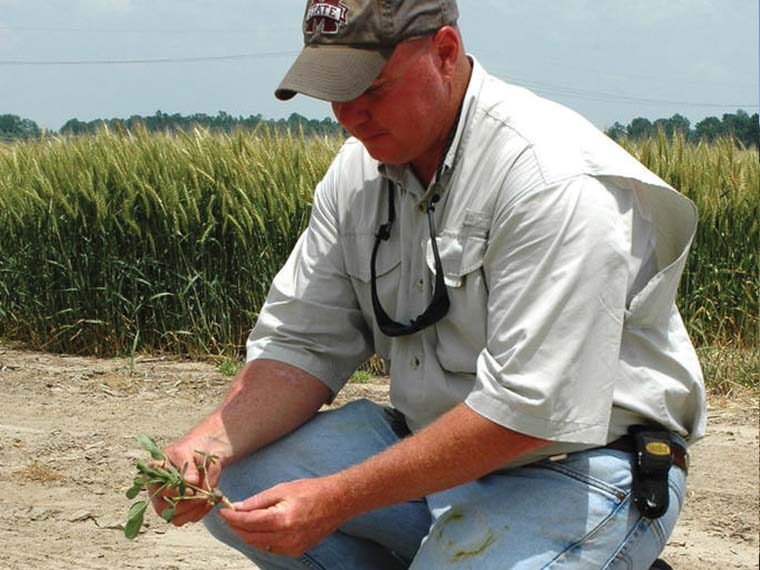The information presented on this page may be dated. It may refer to situations which have changed or people who are no longer affiliated with the university. It is archived as part of Mississippi State University's history.
Some 29,000 acres of peanuts were harvested in Mississippi in 2014. As acreage increases, so does the need to develop new methods to control insect pests. In 2014, Jeff Gore, an associate extension and research professor at the Delta Research and Extension Center in Stoneville conducted multiple experiments studying insect management in peanuts.
Funded through the Mississippi Peanut Promotion Board, Gore evaluated thrips management over multiple planting dates. Fungicide seed treatment had better stand establishment than treatments without fungicide. Heavy and frequent rainfall impacted initial thrips populations; four to 12 days post emergence, densities were very low. Seventeen days after emergence, populations increased and significant injury was observed in all treatments. Control improved in treatments that received foliar spray with Orthene. Due to heavy rainfall and delayed emergence, insecticides were not effective for control. Despite weather conditions, all of the at-planting insecticides produced greater yields than the untreated control. A new insecticide/nematicide (Velum Total, Bayer CropScience) was evaluated, showing good control and producing greater yields than the untreated control. Caterpillar pest populations were moderate and commercial and experimental insecticides were evaluated for fall armyworm and bollworm control.
In the first experiment, CruiserMaxx, CruiserMaxx + Orthene, Thimet, Thimet + Orthene, and two foliar sprays with Orthene were compared to an untreated control. Foliar sprays with Orthene following Cruiser and Thimet improved control compared to each insecticide alone. Two applications with Orthene provided good control. All Orthene applications were applied as foliar sprays after emergence. All insecticide-treated plots produced greater yield than the untreated control except Thimet alone. Yields were 351 pounds greater where Orthene was added to Thimet compared to Thimet alone. Two foliar applications with Orthene provided similar yields to all other insecticide treatments.
In the second experiment, Velum Total (Bayer CropScience) was compared to Thimet and Admire Pro for early season control. Velum Total applied as an in-furrow spray produced yields similar to or better than Thimet and Admire Pro. While not currently registered, Velum Total should be a valuable tool for early season pest management. All insecticide treatments had greater yields than the untreated control.
In other experiments, seed treatment management of early season insects, in-furrow sprays, granular insecticides and foliar sprays produced greater yields than the untreated control. Yields among all insecticide treatments were similar.
Multiple experiments evaluated control of defoliating caterpillars with commercial and experimental insecticides. Populations primarily consisted of fall armyworm and species densities were moderate to high. A bollworm population peak occurred during late-July/early-August. All insecticides evaluated provided good initial control of fall armyworm. Intrepid Edge, Belt, Prevathon, Diamond, Dimilin and DoubleTake provided good control out to 27 days after application. Intrepid Edge, Steward and Prevathon provided good initial bollworm control. Bollworm populations did not persist long enough to evaluate residual control. In the defoliating caterpillars experiments, no significant yield differences were observed for any of the insecticides compared to the untreated control. However, untreated control yields tended to be numerically lower than insecticide treatments, especially in treatments that provided extended residual control of fall armyworm.
Results indicate early season insect management is important to maximize peanut yields.

